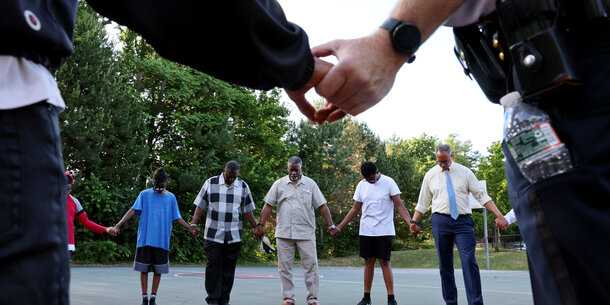In his new book, Bill Keller grapples with the purpose of prison during a time of increased political polarization, newly articulated fears of crime, and budget cuts thwarting reform efforts in corrections departments across the nation. Keller, the former executive editor of the New York Times and founding editor of the Marshall Project, explores with journalistic inquisitiveness some promising efforts and innovations that, if replicated to scale, could transform America’s prisons and jails.
Many of the statistics in Keller’s book are not new, but they still stun in their depiction of a nation that is punitive above all else in its response to social harm. Keller highlights how, after the 1994 crime bill eliminated federal Pell grants for students behind bars, “the number of college programs in American correctional facilities plummeted from nearly 800 to fewer than a dozen.” America boasts 45,000 federal and state laws that govern life after incarceration: laws that restrict housing for those with a felony conviction and laws that prohibit the right to vote in some states. America spends at least $80 billion a year on corrections, and between 40 and 50 percent of people who leave prison return. The Brennan Center’s own research has found that almost 40 percent of our nation’s state and federal prison population does not need to be behind bars for public safety reasons and that, on average, formerly imprisoned people earn nearly half a million dollars less over their careers than they might have otherwise. Nearly a third of Black men in the United States spend time in jail or prison.
The Covid-19 pandemic has brought heightened media attention to conditions of confinement in correctional and detention facilities given the impossibility of social distancing behind bars, inadequate medical care, and the lack of hot water, soap, and masks. Since the start of the pandemic, prisons and U.S. Immigration and Customs Enforcement detention centers across the country have reported at least 3,159 Covid deaths among incarcerated people and 310 cumulative deaths among staff. Beyond the devastating toll of sickness and death, Keller acknowledges that the pandemic has also hindered reform efforts, from the almost complete stoppage of in-person education behind bars to the conversion of potentially innovative prison facilities into quarantine zones.
While there has been a surfeit of recent books highlighting the overwhelming harms of America’s reliance on mass incarceration, Keller looks at what might be possible, highlighting groundbreaking programs that humanize one’s experience behind bars.
Many of the innovative programs highlighted in Keller’s book are based on the Scandinavian approach to corrections, which emphasizes human dignity above punishment. One chapter details The Little Scandinavia project, a housing unit within a medium security state prison in Chester, Pennsylvania, that aims to create a climate of mutual respect. The program provides rehabilitation and addiction therapy, as well as reentry training. Unlike other U.S. prison facilities, the unit has a kitchen and a washer and dryer, attempting to normalize life behind bars and helps prepare the men for release.
The book features several other pioneering programs that move away from the dehumanizing norms of many jails and prisons in the United States. For example, former North Dakota Department of Corrections and Rehabilitation Director Leann Bertsch transformed the recruitment and hiring of corrections staff, again inspired by a visit to Norwegian prisons. Bertsch told Keller, “We started to hire people who wanted to be agents of change, not people who wanted to exercise authority.” Keller also interviews those who founded or now run transformative high school and post-secondary education programs such as the Bard Prison Initiative and Mount Tamalpais College, an independent liberal arts college specifically dedicated to serving incarcerated students. But these programs are few and far between, light years short of providing high school and college classes to the almost 2 million people in America’s jails and prisons.
Large-scale change will not be easy, as Keller acknowledges. The U.S. has one federal, 50 state, and 18,000 local prison systems. According to the Prison Policy Initiative, America holds almost 2 million people inside of 1,566 state prisons, 102 federal prisons, 2,850 local jails, 1,510 juvenile correctional facilities, 186 immigration detention facilities, and 82 Indian country jails, as well as in military prisons, civil commitment centers, state psychiatric hospitals, and prisons in the U.S. territories.
Keller also portrays the tension between reformers and corrections staff who often scoff at comfortable living quarters for incarcerated people, criticize the need for so many educational programs, and frequently serve as a bulwark against reform. Yet the book is nuanced and highlights the difficult working conditions for correctional staff who suffer from high suicide rates, low pay, and double or triple shifts that many are required to work due to staff shortages. Keller points out that we don’t need to accept that reality, highlighting how Oregon’s prison system strove to change correctional culture there and prioritize the health and well being of their corrections staff.
What’s Prison For? is a short book, perhaps more of a survey of recent reforms that attempt to add some dignity to one’s time behind bars. Given the book’s length, it necessarily leaves out important work that others are doing to transform prisons and jails, such as the expanding role of oversight in improving conditions of confinement. Organizations like the UCLA Law Covid Behind Bars Data Project and the Prison and Jail Innovation Lab are filling government holes in data collection and connecting research with on-the-ground reforms to push for and improve on independent correctional oversight and better prison conditions. These and other critical oversight projects are worth spotlighting.
Nevertheless, it’s rare to finish the last page of a book on the criminal legal system with hope, and one does walk away with a sense that even just one person can positively impact lives of those behind bars. While the question of what prisons are for can’t be answered by any one text, Keller’s contribution to the conversation is an important one.



